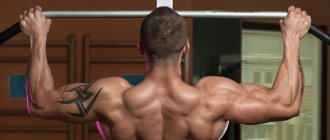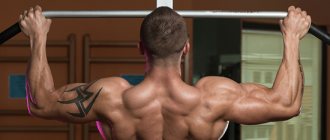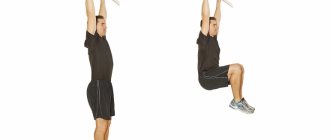Boxing school > > Practice > > Pull-up program 30 weeks
How often, looking at yourself in the mirror, have you thought that it’s time to get your figure in order? To do this you need to play sports. The most common, affordable and effective equipment for sports is the horizontal bar. It can be found in the gym, on the street, playground, beach. Or you can do it differently, buy it in a store and hang it in your doorway at home. This will allow you to train in any weather and at any time convenient for you.
If you don't know how to do pull-ups, then you should start your training with negative pull-ups or pull-ups with a partner. After you master these pull-ups, you can safely move on to regular ones. And here you can use the 30 week pull-up program . You will learn to do 25-30 pull-ups in one approach, or even more!
What exercises can you do on the bar?
The crossbar provides a wide field for sports imagination. Here you can perform a huge number of exercises that develop different muscle groups.
Burpee
The burpee exercise is popular among athletes of various categories, especially among martial artists who prefer to develop endurance, agility and strength.
The execution method is as follows: you need to take the IP. – stand in front of the horizontal bar, arms at your sides, feet shoulder-width apart. We squat down at a fast pace, jump into a prone position and do one push-up. We also dynamically return to a squatting position with a jump, jump again and return to the standing position, pull ourselves up, and jump to the ground. Exercise.
Core
Core is a set of exercises for developing mass, strength and endurance, training different muscle groups.
The technique of performing “core” must be adopted i.p. – arms down, feet shoulder-width apart. We jump up to the horizontal bar, pull ourselves up, raise our straight legs perpendicular to the body, lower them down, raise our legs again, but now bent at the knees at a right angle. Then we lower our legs again and raise them again, this time up, so that our toes touch the crossbar. We jump to the ground and repeat the exercise at least five times.
But among all the existing techniques with a horizontal bar, the most popular is the pull-up training program, which, with due persistence, will help build strength and endurance.
It’s worth dwelling in a little more detail on the issue of competently performing pull-ups on the horizontal bar, because the final result largely depends on the quality.
How to do pull-ups correctly
The back and legs must be straight, you need to rise all the way to touch the bar with your chin.
The crossbar is fraught with a lot of secrets, knowing which you can quickly get yourself into perfect shape.
- If you are going to build mass, then you need to go up slowly and come down quickly.
- If you need to strengthen your muscles, increase power and endurance, then you need, on the contrary, to quickly rise and descend slowly.
- For good stretching and flexibility, you need to quickly perform both the ascent and descent, and give yourself about ten seconds of sagging in between sets.
There are several types of pull-ups, let's look at them.
- Straight grip. The backs of the hands are directed towards the crossbar.
- Narrow - arms are located at shoulder level.
- Average - hands at the level of ten centimeters wider than the shoulders.
- Wide - unlike the first two, it implies a wide placement of the hands at the maximum distance from each other.
- Reverse grip. The hands are directed with the palms towards the horizontal bar. Like the direct grip, the reverse grip is divided into three subtypes:
- narrow;
- average;
- wide.
Different goals - different techniques
Many people can do pull-ups a small number of times, but to influence a specific muscle group, you need to perform the exercise correctly. As practice shows, even experienced and developed athletes do not always manage to do more than five pull-ups correctly. Before performing a pull-up program at home, a good warm-up and warm-up of the muscles is necessary.
- Maintaining correct body position. You need to fix your legs, you can fix them together and bend your knees at an angle of ninety degrees. In this position, lifting is carried out due to the strength of the arm muscles (the help of the legs and pelvis is excluded), and the work of the back is felt.
- Frequency and effort. To thoroughly work out the muscles, the exercise is best performed slowly, that is, lifting and lowering the body should be done at the same speed and evenly. There should be no jerking when moving. Hands must be kept tense. Muscle mass should be felt.
- Correct breathing: when ascending, inhale evenly, when lowering, exhale.
Not everyone training at home pays attention to the position of their hands on the horizontal bar, but it is the grip that determines which muscle group the main load will be directed to. The grip of the bar varies as narrow, medium and wide.
- Narrow - used to train the forearm and biceps, excluding the action of the back muscles, performed with the arms as close as possible.
- Medium - the position of the hands corresponds to the width of the shoulders. The load is distributed evenly. The arms, shoulders and back are equally involved in raising the torso. The most common grip when doing pull-ups.
- Wide - performed with the greatest mutual distance between the hands. To create the greatest load, the thumb does not wrap around the horizontal bar. Designed to train the back muscles.
By doing pull-ups you can develop both strength and muscle mass. To learn how to competently do a certain slope, you need to remember what this exercise consists of. It consists of two stages:
- Positive phase - body lifting
- Negative phase - lowering the body
These phases are present in all strength exercises and are worth considering in more detail.
To generate force:
- Within three seconds, slowly raise the body, and lower it quickly - in one second.
- Gradually increase the number of approaches
- Create muscle tension when lifting
- Rest between sets for no more than two to three minutes.
Working for mass:
- Raise your torso quickly for one second and slowly lower it in about three seconds.
- Constant number of approaches without increasing
- When lowering the body, the muscles should be as tense as possible
- Rest between sets for more than three minutes
- After training at home, take a sufficiently energy-rich diet.
As you can see, the program for weight pull-ups at home has the opposite bias than for strength development. When pull-ups are easy, weights can be used to complicate the exercise at home. To increase your own weight, belts with weights attached to them, leg weights, and backpacks with sand are used.
Teenagers are taught to do pull-ups in physical education classes at school.
Basic knowledge of pull-up techniques
The technique of pulling up on a horizontal bar requires the physical athlete to master basic skills.
♦ Do not perform the exercise with sudden jerks - this can lead to injury to the cervical vertebrae or the development of herniated intervertebral discs.
♦ There is no need to squirm when lifting; you need to keep your body in a strictly vertical position (well, if only with a slight arch in the back).

♦ Many novice athletes do not know how to breathe correctly when doing pull-ups on the horizontal bar. Meanwhile, this is an important point.
If you do not learn proper breathing when performing an exercise, it will slow down your athletic progression.
The rules are simple: at the top point we exhale sharply, and then when lowering, take a deep breath. And under no circumstances hold your breath - this will quickly cause you to lose strength and energy.
Learn how to do an exercise on the horizontal bar for beginners: for example, try to master a single pull-up.
Pull up once, climb down, rest, shake your hands, and then repeat. After mastering single repetitions, move on to multiple pull-ups.
After twenty to twenty-five days, switch to regular full lifting and lowering. At the same time, do not forget to put gloves on your hands for doing pull-ups on the horizontal bar - with them you will be able to avoid the appearance of calluses on your palms, besides, the gloves absorb sweat and will not allow your hands to slip off the bar.
There is a whole set of exercises on the horizontal bar, but before moving on to mastering it, you should count your horizontal bar achievements at least ten times. To increase the number of times it is advisable to use weights. A special vest is sold in stores. There is also an economical option: fill your backpack with plastic bottles of water or any weighty objects without sharp corners - and please, train!
You can increase the weights over time, but don’t get carried away; take a day or two to rest. It is a big misconception that the more you train, the stronger you become – nonsense! The body becomes stronger with rest!
Let's figure out how to increase the number of pull-ups on the horizontal bar, what needs to be done for this?
How can a beginner learn to do pull-ups?
If you can't do a single pull-up, there are several options. Using one of them it is much easier to learn how to do pull-ups on the horizontal bar.
- You can use a stool. By standing on it, it is easier to pull yourself up on the horizontal bar. At the top point, you must try to stay in a taut position for three seconds, gradually increasing this figure to seven seconds, and jump to the ground. You need to repeat this 5-7 more times.
- There is another method - belaying with rubber. By tying yourself around the waist with a wide sports rubber band and hanging it high from the horizontal bar, it is easier to return to the highest point of the pull-up. After a week, you will be able to work on the horizontal bar without insurance.
- Beginners perform pull-ups with jerks. This significantly makes the task easier at the first stage, but after five to seven days you need to abandon this help and perform the training according to all the rules.
A month is usually allotted for training. You can use the following table.
Pull-up program on the horizontal bar in the form of a table
| Approach number/week | 1 | 2 | 3 | 4 |
| 1 | 4 | 5 | 7 | 9 |
| 2 | 3 | 4 | 6 | 8 |
| 3 | 3 | 4 | 6 | 9 |
| 4 | 3 | 5 | 7 | 9 |
As you can see from the table, you need to increase the load gradually, carefully, so as not to lead to injuries and overwork. After the first month of training, you need to increase the load 2-3 times.
Before you start training on the horizontal bar, you should learn the following rules that will help you avoid injuries and achieve excellent results.
- Before training, a short warm-up is necessary. 5-10 minutes of cardio will be quite enough, and this can be not only running, jumping or jumping rope, but also fast walking, cycling or something else that could thoroughly warm up the body and prepare it for strength training.
- In order to increase weight, you need to reconsider your diet; it should consist more of proteins. There should be a minimum of sweets. You need to slightly increase the number of calories consumed so that muscle mass does not dry out.
- Each workout should end with a little stretching, which helps the muscles recover faster after exercise, which also allows you to gain weight faster.
The rules are known, now let's start studying serious, professional sports programs.
Pull-up diagram on the horizontal bar
Today, the most popular scheme is considered to be 50 pull-ups on a horizontal bar. To find out which step of the program to start with, you need to pass a test that determines the level of sports training, according to which you can choose the most correct regime. The test is as follows: we do pull-ups on the bar as many times as possible, performing the exercises efficiently (without cheating or jerking). If the maximum number of pull-ups is 7, then the 7-8 program is suitable for you (we’ll talk about it in more detail a little later).
This program involves more rest than subsequent ones; this is the initial stage, starting from which you need to move towards perfection. Here it is important not to waste your energy reserves and willpower when you reach your goal.
Rest between sets should be at least two and no more than ten minutes. You need to eat five times a day, this is the only way the body can work out in the right quality. Having realized that this training cycle is easy to complete, we raise the bar for achievements, moving on to the next cycle 9-11 and so on.
The ultimate goal is to learn to do 50 pull-ups in one set. This skill, of course, is inextricably linked with an ideal appearance, which is what we strive for.
Pull-up training program[edit | edit code]
Basic rules and explanations of the author:
- Bodyweight training program
- Bodyweight strength exercises
Program levels:[edit | edit code]
The ten exercises are called "Ten Levels". By performing them gradually and regularly, the athlete moves from easy to more complex, from beginner to professional level and ensures stable and long-term results. Level One is the easiest option, while Level Ten is the most difficult option for the exercise. It should be noted that a different sequence of exercises will not lead you to your cherished goal - at least not in the foreseeable future. The main goal of such a structure is to show trainees how, without the help of a personal trainer and special equipment, they can learn to correctly perform a series of exercises. Once you can do the Level 10 exercises without much effort, you can consider yourself a master of bodyweight training.
- Level 1
Vertical pull-ups 3 sets of 40, then move to level 2 - Level 2
Horizontal pull-ups 3 sets of 30, then move to level 3 - Level 3
Pull-ups: Jackknife 3 sets of 20, then move on to level 4 - Level 4
Partial pull-ups 2 sets of 15, then move to level 5 - Level 5
Full pull-ups 2 sets of 10, then move on to level 6 - Level 6
Close grip pull-ups 2 sets of 10, then move to level 7 - Level 7
Uneven-high pull-ups 2 sets of 9, then move to level 8 - Level 8
Partial one-arm pull-ups 2 sets of 8, then move to level 9 - Level 9
One-arm pull-ups with support 2 sets of 7, then move to level 10 - Level 10
Pull-ups on one arm 2 sets of 6











